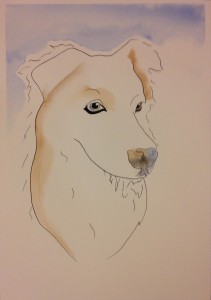|
 Over the summer, I was screwing up the courage to ask someone I followed on Twitter for pictures of their dog for me to paint as my own project. Lilly was a white-faced collie with one blue and one brown eye, and a lovely shape. I had even done a quick pencil sketch of her, some months before, when a photo had taken my fancy. At an inch and a half tall, with a tiny bit of watercolour pencil, she looked good. (The lines around the picture there are because I drew it in a thumbnail book of a sort often used for planning screenplays and comic panels.) However, her owner informed me she had been in a tragic car accident, and so I never asked. I was filing the project away under things not to do when he asked about having her drawn as a Christmas present to the family. Over the summer, I was screwing up the courage to ask someone I followed on Twitter for pictures of their dog for me to paint as my own project. Lilly was a white-faced collie with one blue and one brown eye, and a lovely shape. I had even done a quick pencil sketch of her, some months before, when a photo had taken my fancy. At an inch and a half tall, with a tiny bit of watercolour pencil, she looked good. (The lines around the picture there are because I drew it in a thumbnail book of a sort often used for planning screenplays and comic panels.) However, her owner informed me she had been in a tragic car accident, and so I never asked. I was filing the project away under things not to do when he asked about having her drawn as a Christmas present to the family.
So, rather than a project in oils for my portfolio, I was working to commission. The first thing I did was obtain a brief. My client, Mr Crawford, likes a minimalist style of art, which immediately presented a challenge. I had been thinking of a fully tonal piece, and I had to revise that entirely. Taking away everything which is not strictly necessary to leave behind an image that still has emotion and vigour is a challenge. I did several drawings and one painting with an ink brush, to find the turning points and necessary parts, and then I did a pair of portraits in ink with a dip pen, one for practice and one for finishing.
 Initially, I made one major error, treating the colour as if it was oil. In oil paint, I tend to put a complimentary colour under the top colour to make it brighter. In watercolour, that ends up greying out, and I treated the piece as if it was going to be finished in an oil style. However, watercolour can be removed very carefully, if the pigment does not stain, and the faint remains of the first colour layer did have the effect I was after. I was prepared to redraw the whole thing, but I did not have to. In oils I have to remember not to lick the brushes. In watercolour I have to remember not to paint in oils. (I should also remember not to lick the brushes, but it is not so vital as I do not paint with lead or cadmium.) Initially, I made one major error, treating the colour as if it was oil. In oil paint, I tend to put a complimentary colour under the top colour to make it brighter. In watercolour, that ends up greying out, and I treated the piece as if it was going to be finished in an oil style. However, watercolour can be removed very carefully, if the pigment does not stain, and the faint remains of the first colour layer did have the effect I was after. I was prepared to redraw the whole thing, but I did not have to. In oils I have to remember not to lick the brushes. In watercolour I have to remember not to paint in oils. (I should also remember not to lick the brushes, but it is not so vital as I do not paint with lead or cadmium.)
There were several rounds of feedback – I homed in on what Mr Crawford wanted, and then made a few alterations to bring the piece in line with his final expectations. Mostly it was about texture, as I had left empty spaces within the form on purpose. In all, I charged for a day’s work and did a bit more, but as I did most of the preparatory work outside the Christmas period, it was not a great problem, and that little bit more is something I like doing. Even when I am not painting I tend to be thinking about work in progress, and it helps me later if I get it down on paper when thinking.
|